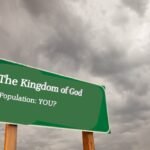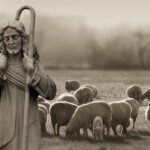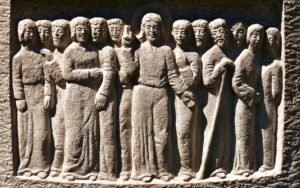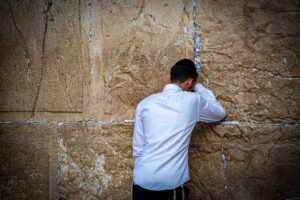God has a wonderful way of revealing the way He’s changing human nature one person at a time and bringing about His overall plan of salvation for mankind. Unfortunately since the Garden of Eden and the fall of man, humanity has sinned against God and earned the ultimate penalty of death (Romans 3:23; 6:23). Thankfully God has provided a way for humanity to be delivered from that fate. God has an amazing plan to restore the relationship that was broken in the Garden and enjoy life eternal as a part of God’s family. Through a series of annual biblical festivals God reveals in a concrete manner how He intends to save us and the rest of mankind. The plan focuses on transforming humanity from the inside out through seven successive steps that teach important truths about our Savior and King, Jesus Christ. The biblical festivals are an invaluable teaching tool to help us focus on God’s plan of salvation.
There are three harvest seasons in the land of Israel and God has used each to demonstrate His outline for “harvesting” human beings in His plan of salvation (Exodus 23:14-17). God’s annual festivals are detailed in Leviticus 23, with each building on preceding ones, each individual part adding to the whole – God’s master plan of salvation.
The first step in God’s plan is symbolized through the Passover season (Exodus 12:21). It represents the first crucial step in God’s plan to save mankind, without this step the other steps would not be possible. Annually we’re reminded that Jesus was put to death so that we can receive forgiveness for sin. The Passover was observed in Israel by slaughtering a lamb – which represented the future sacrifice of Christ (John 1:29). The Passover commemorates what Jesus has done in offering His own life to pay for the sins of mankind. Jesus and His disciples kept this festival (Mark 14:12-14), setting the example that we should follow. Without the fulfillment of the Passover festival, there would be no salvation, thus making the foundation of salvation possible.
Following Passover, the next step is the Feast of Unleavened Bread, which shows mankind what God expects of us beyond accepting Jesus’ shed blood for forgiveness. As leaven was removed from homes and not eaten, Paul applies the symbol of leaven to sin (1 Cor. 5:6-7). Conversely, he explains that unleavened bread represents sincerity and truth – righteousness and holiness. What an opportunity to reflect on Christ who is holy, and that we should become holy as He is (1 Peter 1:16), striving to put sin out our lives through the indwelling Christ in us (Romans 6:6, 17-18; Gal. 2:20). Our ultimate example of living the unleavened life is Christ, and we must follow Him in faith to salvation and eternal life.
The third step celebrated is the Day of Pentecost, Feast of Harvest or Feast of Firstfruits. Symbolized here are the faithful believers whom God calls the firstfruits of all His harvests (James 1:18; Romans 8:23). On the Day of Pentecost, according to Acts 2, Christ’s followers received God’s Holy Spirit. Upon repentance and baptism, thousands received the Spirit and receiving the Spirit in turn enables us to follow Christ in obedience to His commands (Romans 5:5; 1 John 5:3) and allows us to bear fruit of the Spirit.
The great ingathering harvest in Israel came in late summer and early fall (Exodus 23:16), but the festival period actually commenced with the Feast of Trumpets two weeks earlier. This day was a memorial of blowing of trumpets (Lev. 23:24) and represents the time of the coming of the Messiah to take over the rule of the world (Rev. 11:15; 19:11-21). At the seventh trumpet the world’s governments are transferred over to the rule of the returning Christ and the resurrection of the saints (1 Cor. 15:52; 1 Thess. 4:16) – at last receiving ultimate salvation from death through transformation into immortal beings. The autumn celebrations point to a time when Jesus will assume control over the affairs of the whole world – ushering in a new age – the Kingdom of God in its fullness.
The fifth step in God’s master plan is foreshadowed by the Day of Atonement. Historically this was a time when the entire nation of Israel was ceremonially cleansed of sins committed in ignorance (Lev. 16:29-34; Heb. 9:7). This pictures the real cleansing of the entire world of its spiritual ignorance and blindness. A time when we will be at-one-ment with God. The one responsible for humanity’s spiritual ignorance and deception is Satan the devil (Rev. 12:9). One of the first events after Christ’s return is the banishment of the great deceiver (Rev. 20:1-3). All people can become reconciled to God, through the atoning sacrifice of Christ. For the first time in the history of mankind, we will fully experience peace on earth, with God’s will for people no longer being resisted by Satan.
Finally, God will fulfill His promise to bring peace on earth. Jesus will take over the rule of this world, Satan will be deposed and the world will be at-one with God, then Jesus and His resurrected and transformed saints will reign on the earth for a thousand years (Rev. 5:10; 20:4, 6). A time when Christ will tabernacle with His people, as He did long ago while journeying through the desert. Yet realizing this is a temporary age, anticipating a permanent new heaven and new earth to follow. This time pictures the ultimate spiritual harvest of humanity yet to come. What a time we have to look forward to (Hebrews 8:10-11).
Following the Feast of Tabernacles, the Eighth Day further celebrates the final spiritual harvest of mankind, portraying events that will immediately follow the millennial reign of Christ and the saints. This last festival pictures the great white throne judgment (Rev. 20:11-12) demonstrating how Christ wants to save lives, not lose them (1 Peter 4:17). The rest of the dead (Rev. 20:5) includes all people who lived but were not converted to God’s way from Adam to Christ’s second coming. Unfortunately, not all will choose salvation. Those who ultimately refuse to repent will be destroyed in a lake of fire (Rev. 20:14-15; 21:8), creating a new era with a new heavens and a new earth with God the Father and Jesus dwelling with glorified humanity forever (Rev. 21-22).
God’s festivals are a magnificent tool to help us understand how mankind is to be saved, helping to bring His plan into focus. Every year we’re reminded how the feasts of the Lord are a shadow of things to come and Jesus is at the center of all of them. Christ is playing a central role in carrying out God’s plan of salvation for mankind and God’s festivals are a perfect object lesson to help us focus on that miraculous plan.























